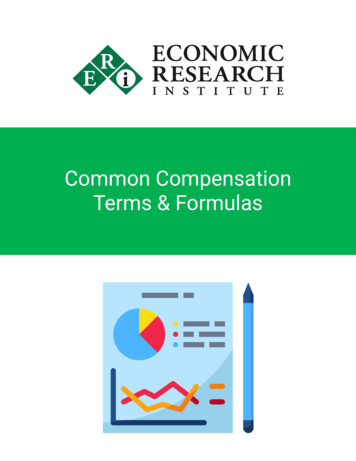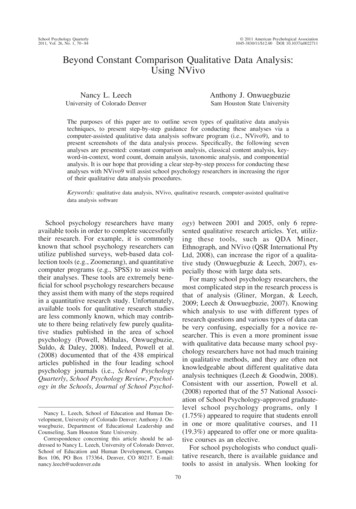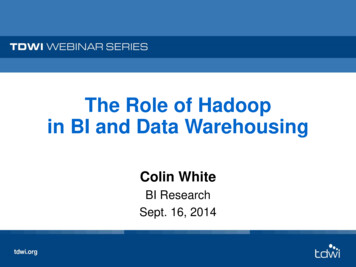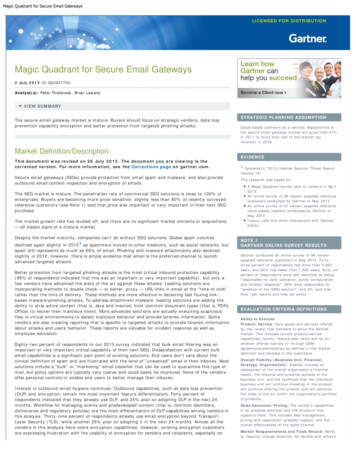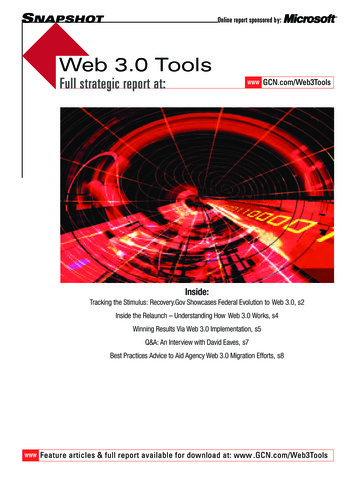
Transcription
fourth quarter 2007TDWI Technology Market Reportdata integration ToolsComparison and Market AnalysisBy Philip Russomand Mark Madsen
Fourth quarter 2007TDWI Technology Market ReportData Integration toolsComparison and Market AnalysisBy Philip Russom and Mark MadsenTable of ContentsIntroduction . . . . . . . . . . . . . . . . . . . . . . . . . . . . . . . . . . . . . . 3Data Integration Practices, Tools, Suites,and Platforms . . . . . . . . . . . . . . . . . . . . . . . . . . . . . . . . . . . 3Data Integration Market Overview . . . . . . . . . . . . . . . . . . . 4Year in Review . . . . . . . . . . . . . . . . . . . . . . . . . . . . . . . . . . . 4The Year Ahead . . . . . . . . . . . . . . . . . . . . . . . . . . . . . . . . . . 7Defining the DI Platform . . . . . . . . . . . . . . . . . . . . . . . . . . . . 8The Modules of a DI Platform . . . . . . . . . . . . . . . . . . . . . . .8Other Features of a DI Platform . . . . . . . . . . . . . . . . . . . . 10Vendor Comparisons . . . . . . . . . . . . . . . . . . . . . . . . . . . . . . 10Goals of Software Vendors Relevant to DI Platforms . . . 10DI Vendors by DI Platform Breadth . . . . . . . . . . . . . . . . . 11DI Platform Modules per Leading Vendor . . . . . . . . . . . . 11Profiles of Leading DI Vendors . . . . . . . . . . . . . . . . . . . . . 13Business Objects . . . . . . . . . . . . . . . . . . . . . . . . . . . . . . . . 13IBM . . . . . . . . . . . . . . . . . . . . . . . . . . . . . . . . . . . . . . . . . . 14Informatica . . . . . . . . . . . . . . . . . . . . . . . . . . . . . . . . . . . . 15Microsoft . . . . . . . . . . . . . . . . . . . . . . . . . . . . . . . . . . . . . . 15Oracle . . . . . . . . . . . . . . . . . . . . . . . . . . . . . . . . . . . . . . . . 16SAS . . . . . . . . . . . . . . . . . . . . . . . . . . . . . . . . . . . . . . . . . . 17Niche Vendors . . . . . . . . . . . . . . . . . . . . . . . . . . . . . . . . . . . 18Recommendations . . . . . . . . . . . . . . . . . . . . . . . . . . . . . . . . 19www.tdwi.org1
data in t egr at ion t ool sAbout the AuthorsPHILIP RUSSOM is the senior manager of TDWI Research at The Data Warehousing Institute,where he oversees many of TDWI’s research-oriented publications, services, and events. Prior tojoining TDWI in 2005, Russom was an industry analyst covering BI at Forrester Research, GigaInformation Group, and Hurwitz Group. He also ran his own business as an independent industryanalyst and BI consultant, and was contributing editor with Intelligent Enterprise and DM Reviewmagazines. Before that, Russom worked in technical and marketing positions for various databasevendors. You can reach him at prussom@tdwi.org.MARK MADSEN is president of Third Nature, a technology consulting and market research firmfocused on business intelligence, data integration, and data management. Mark is an award-winningarchitect and former CTO whose work has been featured in numerous industry publications. He isa principal author of Clickstream Data Warehousing and frequently speaks at conferences and writesabout business intelligence and emerging technology. For more information or to contact Madsen,visit http://ThirdNature.net.About TDWI ResearchTDWI Research provides research and advice for BI professionals worldwide. TDWI Researchfocuses exclusively on BI/DW issues and teams up with industry practitioners to deliver both abroad and deep understanding of the business and technical issues surrounding the deployment ofBI/DW solutions. TDWI Research offers reports, commentary, and inquiry services via a worldwideMembership program and provides custom research, benchmarking, and strategic planning servicesto both user and vendor organizations.About TDWI’s Technology Market ReportsTDWI Technology Market Reports provide TDWI Members an annual overview of an importanttechnology sector within the business intelligence (BI) market. Technology Market Reportshighlight the major events in the sector for the previous 12 months, predict the segment’s futuredirection, and provide a comparative review of the leading products in the sector as well as asummary description of niche segments and players. The reports aim to help business customerscreate a shortlist of products that they can evaluate in more depth before making a purchase, or tovalidate the direction and capabilities of an existing product.2TDWI rese a rch 2007 by 1105 Media, Inc. All rights reserved. Printed in the United States. The Data Warehousing Institute (TDWI) is a trademark of 1105 Media,Inc. Other product and company names mentioned herein may be trademarks and/or registered trademarks of their respective companies. TDWI is adivision of 1105 Media, Inc., based in Chatsworth, CA.
IntroductionIntroductionData Integration Practices, Tools, Suites, and PlatformsAs we’ll see in this report, data integration (DI) is practiced in different ways, with different toolsand techniques, in response to different technical and end user requirements. The dizzying arrayof options is itself a barrier to action. To help technical users clear the barrier, this report segmentsthe leading practices, tools, related technologies, and suites for DI.1 Based on the segmentationpresented in this report, a technical user should be able to identify a DI practice that’s appropriate tohis/her organization, understand what combination of tools and technologies is required, then draftan evaluation list of vendor products that maps credibly to his/her requirements.But first, we need to define key terms and concepts used in this report. Data integration (DI). In its complex manifestations, DI collects data from multiplesources, transforms and integrates this disparate data into a common data model, and loadsthe integrated data into a target database, application, or file. In its simple forms, DI merelyextracts data from one source and copies it into a target. When done well, DI adds value todata by improving its content (which may require an additional data quality solution) or bycreating data structures that wouldn’t exist without DI (which is key to data warehousing). DI practices. The term data integration is a broad umbrella that includes multiple DI practices, namely: extract, transform, and load (ETL), enterprise information integration (EII),enterprise data replication (EDR), and enterprise application integration (EAI). Technicalusers implement these practices with hand-coding, vendor tools, or a mix of the two.2 DI-related practices. Data integration is a data management practice, as are its multiplepractices. To further complicate the matter, data integration is regularly practiced in tandemwith other data management practices, including data quality, data profiling, metadatamanagement, master data management, sort, and so on. Hence, a DI implementation of anysize and maturity is today rather complex, involving a collection of DI and related practices,possibly with a unique vendor tool or hand-coded solution for each. Data integration suites. When technical users began applying multiple DI and DI-relatedpractices to their DI initiatives, software vendors responded by building and acquiring moretools. As a result, several DI vendors (like Business Objects, IBM, and Informatica) nowhave suites of tools or modules—one each for individual DI and DI-related data management practices. The main benefit of a tool suite is that users have a single vendor to workwith for the acquisition and support of multiple tools. The problem, however, is that toolsand modules of the suite (especially when the vendor acquired them, instead of buildingthem) do not integrate and interoperate deeply, if at all.The most influential trendtoday is the evolution ofDI tools into suites and(eventually) platforms.1. Segmentation is an analytic method that reveals the constituent parts of a thing, then sorts the parts by criteria like cost,complexity, type, approach, technologies required, or applicability to a known goal.2. For a detailed comparison of DI practices, see the TDWI Best Practices Report Data Integration: Using ETL, EAI, and EIITools to Create an Integrated Enterprise (November 2005), available online at www.tdwi.org/research.www.tdwi.org3
data in t egr at ion t ool s Data integration platforms. The trend toward DI tool suites has influenced vendorproduct offerings deeply in recent years. Yet, it’s now being superseded by a grander trendtoward DI platforms. The DI platform seeks to correct the suite’s lack of interoperability viathe full integration of common tool elements, including those for deployment (metadata,servers, security, interfaces for data access or interoperability with other tools) and development (user interfaces for design, collaboration, management, security).Note that DI platforms don’t exist yet. A few years will pass before vendors finish assembling theirsuites and integrate them into true platforms. In its discussions of vendor products, this reportfocuses on the transition from DI suites to DI platforms, because this trend is the strongest definingcriterion for DI product offerings today. In turn, it’s an issue that confuses technical users who mustselect a vendor and a product. Suites and platforms make it difficult to sort out which vendor haswhich kind of tool, as well as which are best-of-breed and which interoperate appropriately. Thisreport seeks to alleviate some of this confusion.This report highlights ETL because it’s the preferred approach for analytic DI, which involvesbusiness intelligence and data warehousing. And ETL is well on its way to becoming the preferredapproach to operational DI, which involves database consolidations and migrations.Data Integration Market OverviewYear in ReviewThe past 12 months have seen a lot of action in the DI tools market. Several major acquisitionsaccelerated the already brisk pace of market consolidation, while the advent of new low-costproviders, including open source DI vendors, brought more choices and increased pressure onproduct pricing. A number of vendors introduced innovations that will enable DI to penetrateorganizations more deeply.Key Events in the Past 12 MonthsHere are the top-line industry events during the last year:Market consolidationcontinues as largevendors buy small ones. July 2007 – IBM acquires DataMirror. IBM’s Software Group continued its shoppingspree (at least 30 acquisitions this decade) by acquiring DataMirror Corporation, whichbrings best-of-breed enterprise data replication (EDR) into IBM’s portfolio. Although IBMalready has replication tools and replication capabilities built into various products (likeDB2), the DataMirror Integration Suite is more open to heterogeneous environments. Plus,it supports advanced functions not seen in most replication tools, like data transformationand bidirectional data synchronization. DataMirror’s changed data capture and real-timeoperation should help bolster IBM’s on-demand computing strategy. This acquisitionreminds us that replication—though as old as computing itself—remains a valuable dataintegration practice. Early 2007 – Talend Software launches. Talend joins the small but growing communityof vendors—including Apatar and Pentaho—that offer commercially supported open sourceETL software. Now that open source has arrived for DI tools, users have more options toconsider. Though not completely free (support still has a price), open source DI tools cost4TDWI rese a rch
Data Integration Market Overviewconsiderably less than their proprietary cousins. And it’s now possible to start with an opensource ETL tool and consider moving to more expensive proprietary software in the future,if requirements demand it. Early 2007 – HP acquires Knightsbridge. This regional system integrator is known forits well-respected data warehouse practice. But Knightsbridge also has a DI practice that’sconsidered one of the best for “big data”—that is, integrating terabyte-scale volumes of data.As no coincidence, HP announced the acquisition of Knightsbridge just before announcingNeoView, HP’s new multi-terabtye-scale data warehousing appliance. Late 2006 – IBM launches Information Server. This is an important milestone on IBM’spath to a unified DI platform, because Information Server pulls together several servers andtool user interfaces to make working with multiple DI and DI-related products from IBMmore seamless. In many ways, IBM Information Server is a result of the product integrationinitiative Ascential Software started before being acquired by IBM in 2005. IBM’s DI platform isn’t finished or fully unified, but IBM has shown a commitment to making it so.New DI vendors andproducts continueto emerge. October 2006 – Oracle acquires Sunopsis. Oracle has been a DI vendor for years, offeringOracle Warehouse Builder (OWB), a batch-oriented ETL tool designed largely for use withOracle databases. Sunopsis is complementary, with its focus on ELT and real-time operation.Curiously, however, Oracle has folded Sunopsis into its Fusion Middleware product line,where it provides near-time DI in the context of an application integration suite. After all,most enterprise application integration (EAI) tools are weak on query and DI, which areuseful when application integration is data-intense. May 2006 – IBM acquires Unicorn. This move gained IBM an independent tool forenterprise metadata management. At the time, IBM representatives described Unicorn asthe eighteenth integration- or process-oriented acquisition since 2001. This acquisitionhighlights how important metadata management is to data management in general andDI specifically. Mid-2006 – Business Objects redefines EIM. The concept of enterprise informationmanagement (EIM) has been around for years with a focus on database administration. ButBusiness Objects’ redefinition puts DI and DI-related practices at its core, along with theirclose ties to BI platforms for reporting and data analysis. Business Objects’ EIM productoffering includes most of the modules this report requires of a DI platform, which makesBusiness Objects—well known as a major BI vendor—also a leading DI platform vendor.www.tdwi.org5
data in t egr at ion t ool sKey Trends in the Past 12 MonthsBelow is a summary of the top trends in the DI tools market: Vendor offerings are evolving from individual tools to suites and platforms of tools. Aspointed out earlier, the trend that most defines vendor products has been, for several years,the movement toward suites of tools for DI and DI-related tasks (like data quality, profiling,and master and metadata management). The trend toward DI suites is currently evolvinginto a trend toward DI platforms. The difference is that a suite is a collection of largelyautonomous tools, whereas a platform unifies them into fewer servers and a common userinterface for development and deployment across all tools. Although this trend is about vendorproducts, it’s driven by the rising user practice of applying multiple DI tools tosingle initiatives.The leading driver for DIvendor acquisitions is thebuild-up of DI suites andplatforms. Market consolidation continues as vendors acquire each other. DI suites and platformsrequire multiple DI and DI-related tools, and there’s a limit to how quickly a softwarevendor can build new tools. Hence, the trend toward DI suites and platforms is the leadingdriver for most of the acquisitions made this decade in the DI vendor community. This isespecially true of acquisitions made by Business Objects, IBM, and Informatica, which are atthe forefront of DI platform development. The ramification of market consolidation is thatusers have fewer vendors to buy tools from. This is good for users who wish to consolidatesuppliers, but not so good for users who desire an independent DI vendor. Integration approaches are converging. For example, EAI, EII, and replication continuallyimprove their data transformation and bulk data capabilities such that they more closelyresemble ETL. At the same time, ETL is improving near-time operation to resemble the otherapproaches. As vendors combine overlapping tools in suites and platforms, more convergenceoccurs. This makes it harder for users to choose the best DI approach for a project, but allowsthem to stretch the use of a DI tool to cover some of the capabilities of other tools.The two leadingchallenges to DI successtoday are data volume andreal time. The volume of data continues to increase. Scaling up to terabyte-scale data volume is theleading challenge to DI today. To achieve scalability, both user-built solutions and vendortools rely heavily on parallel processing, distributed DI architectures, clusters or grids ofservers, and the massive addressable memory of 64-bit servers. Data collection occurs more frequently, pushing toward real time. While the 24-hourcycle is still the norm for running DI jobs that refresh target databases, DI is more and moreasked to access, collect, and integrate data multiple times a day. The consequence is that DImust still support older batch functions, but also newer, real-time ones. As users embracetime-sensitive business practices like on-demand computing, zero latency, and performancemanagement, they need DI to operate in multiple speeds or frequencies, which a multi-toolDI suite or platform does. Federated approaches to DI continue to gain ground. Enterprise information integration(EII) is by nature federated, as are database functions like database views (whether materialized or not). The point of federation is to leave data where it originated and access itsmost recent value on an as-needed basis. The use of federation in DI solutions continues toincrease, but at a glacial pace. Note that federation is one of the capabilities you should lookfor in a DI suite or platform.6TDWI rese a rch
Data Integration Market Overview Hub-and-spoke is the most common DI architecture, soon to be joined by services.First, recognize that DI merits architecture, just as other IT systems do. Without architecture, DI deteriorates into a tangle of unorganized one-off interfaces. Second, hub-and-spokeis still the basis of most DI architectures (regardless of DI practice), although when multipleDI practices are applied, each may have a hub that interoperates with other DI hubs. Third,most users today apply Web services as independent interfaces that contradict DI architecture. As more users learn how to organize a true service-oriented architecture (SOA), expectto see service hubs for DI as well as DI solutions exposed via service hubs.Hub-and-spoke is thepreferred architecturefor integrationimplementations.The Year AheadContinuance of Established TrendsOf the trends just mentioned, scalability and real-time are the most pressing for users because theseare now considered standard requirements, yet are still difficult to achieve. Hence, when users plannew DI work or updates to old work, they should allocate ample man-hours and new technologyacquisitions. The slow adoption of federated DI and changes to DI architecture are not so pressing.As vendors’ suites continue to evolve into platforms, users of DI tools will need to decide carefullywhich additional tools to acquire, which upgrades to apply, and what design changes to make inDI solutions.New or Emerging TrendsYou can expect these trends to continue to gain momentum in the next 12 months, just as they havedone for years now. But these are also joined by new or emerging practices and technologies: Operational DI. DI isn’t just for BI anymore. Analytic DI—usually manifested as ETL insupport of data warehousing—continues to grow as an established practice. But its blue-collar sibling—operational DI—is growing even faster, as DI is regularly applied to operationaldatabase and application consolidations, migrations, synchronizations, and upgrades. Collaborative DI. As the practices of analytic DI and operational DI have grown, so havethe number of DI specialists in data warehousing teams, data integration competencycenters, and on other teams. Very recently, mildly technical business users (like brandmanagers and business analysts) are demanding hands-on access to DI projects and theirdevelopment artifacts. As the DI team gets larger and more diverse, DI tools must providemore collaborative functions for these people. DI high availability. Data integration is being asked to operate more frequently per day,as well as in real time. This is needed to support business methodologies that demand freshdata, like operational BI, on-demand computing, and performance management. Thesemethodologies can’t manage a business without fresh data delivered reliably via real-timeDI, so DI must be continuously available to enable them. Hence, when you cross the lineinto real-time DI, you also cross into DI high availability as a new requirement, which ismet by fault-tolerant hardware and software or a cluster of DI servers that supports failover.Real-time DI requires DIhigh availability, an oftenoverlooked requirement.www.tdwi.org7
data in t egr at ion t ool s Cross-business DI. Long caged by the corporate firewall, DI is now unchained androaming the Internet. As evidence, note the many DI and BI vendor tools that have recentlyadded connectors for Salesforce.com, the quintessential extra-enterprise application. Sincea lot of cross-business communications pass via EDI and XML-based documents, supportfor these and other semi-structured data standards (and translations among them) is a risingrequirement for DI solutions. External data and the Web gain importance. Many organizations provide access tointernal data but have difficulty meeting the user demand for external data. Few are bringing external data from outside sources or Web sites into their environments. Early adoptersare seeing benefits from incorporating this external data, mainly by leveraging specializedintegration tools that evolved for use in an Internet environment. Expect demand for outsidedata to increase and for this trend to continue.Expect to extend DI withtext analytics in the nextthree years or so. Unstructured data is the new frontier for DI. An enterprise data warehouse seeks tobe a “single version of the truth” upon which most organizational decision-making isbased. However, it’s not the whole truth unless it represents information from the massof unstructured data—typically in documents of mostly text, like Microsoft Office filesand e-mails—that all organizations have. The catch is that a specialized technology liketext analytics is required to find and translate text-based information into SQL-accessibledatabase records that data warehouses and BI tools can use. In the next few years, expect toexpand your DI solutions to include text analytic capabilities.Defining the DI PlatformThe Modules of a DI PlatformAs mentioned, a few software vendors are acquiring and building multiple DI and DI-related tools,then packaging them in an integrated suite or DI platform. Before we look at the product offeringsof leading DI software vendors to see how they compare in terms of comprehensive platforms, let’slist the seven tools (or modules) you can expect to find in the ideal DI suite or platform: Extract, transform and load (ETL). ETL is the core engine of a data integration platform.Historically, ETL tools focused on cross-platform movement and transformation of data ina batch processing model. Recent product updates are including more features that allow fortransformation and loading in a near-real-time or streaming model. Enterprise data replication (EDR). Replication is the most commonly used data integration technology today. The basic replication utilities built into most databases simply copydata one-way from one database to another in real time or batch mode with no data transformation other than type conversions. But EDR tools are more feature-rich in that theycan handle bidirectional transfers across different brands of databases. EDR tools may alsosupport advanced features like data transformation and changed data capture.8TDWI rese a rch
Defining the DI Platform Data federation / enterprise information integration (EII). Federation is a method foron-demand data access. Unlike data movement technologies, federation leaves the data inplace at the sources. This makes federation appropriate for a different set of integrationproblems, such as providing current data for on-demand reporting or making live data fromseveral systems appear as if it were from a single table. Data profiling. Profiling is a loose term that describes automated data analysis used togain insight into the data being integrated. Data profiling ranges from basic features, likecounting distinct values or nulls in columns, to advanced abilities, such as relating datafrom different sources based on the patterns and values in the fields. Most DI productsprovide basic profiling features in the development environment but charge for fullfeatured profiling. Data quality. The primary purpose of data quality tools is to standardize data elements andprovide consistent verification and validation rules. The roots of most data quality tools arein name-and-address cleansing and other customer data issues. Modern tools have extendedthose features to address other data types (like product, location, and employee data) andprovide features for generic pattern matching, dictionary and synonym lookups, and standardization to various industry formats. Metadata repository. Metadata is everywhere, so almost every data management toolincludes a metadata repository and other functions for managing metadata. For example,most DI products provide basic metadata reporting services as part of the developmentenvironment. Metadata repositories sold as separate modules include features like importand versioning of metadata from separate modeling and business intelligence environments,tracing data lineage from source to the point of usage, and end user metadata reporting.Most multi-tooltechnology stacks arestitched together withmetadata, as are DI suitesand platforms.In many tools the metadata repository also manages non-metadata entities, like developmentobjects, project documents, and team communications (like annotations and threads associated with objects and documents). Since team members tend to collaborate through theseentities, the repository enables a form of collaborative DI. Master data management (MDM). MDM is the practice of defining and maintainingconsistent definitions of business entities (like customer, product, employee), then sharingthem via data integration and application integration techniques across multiple IT systemswithin an enterprise and sometimes beyond to partnering companies or customers. Moresimply put: MDM is the practice of acquiring, improving, and sharing master data.www.tdwi.org9
data in t egr at ion t ool sOther Features of a DI PlatformAside from the modules just listed, other key elements are part of a DI platform. These are notseparate modules, but components or features inherent in the platform's design. Shared metadata. Metadata support and use is at the core of these products. Even when avendor provides a metadata product, that does not mean their own modules interoperate ona shared metadata framework; yet this is key to a unified platform. Without it you have a setof standalone modules. Centralized management and administration. As with metadata, the ideal platformshould provide for centralized management of all the modules. Even though modules may belogically or physically separate, there should be centralized logging, monitoring, and controlof services. It’s not a platform if all the pieces have to be managed independently. Scheduling and monitoring. Every product should have the ability to monitor, start,suspend, and stop jobs, show their status, and allow an administrator to see errors. Thiscapability should be available from a single point, yet provide a view across operatingsystems, sources, targets, and servers.Vendor ComparisonsGoals of Software Vendors Relevant to DI PlatformsThe DI platform is a goal for only a few vendors, and it will be years before these are complete:DI suites are movingtargets, and DI platformshaven’t truly emerged.Expect them to improve. DI platforms don’t really exist, yet. It’s important to note that not all DI vendors currentlysupport all of the modules and features listed here as required or desirable for a DI suite orplatform. Even when these exist today, the degree of functionality of competing productsdiffers dramatically, as does the degree of interoperability among the modules and featuresof a suite or platform. Hence, you should think of every DI platform as a work in progress.The list of modules and features per vendor will increase regularly, and the amount ofinteroperability between modules of the same platform will improve over time. Not all vendors will build a DI platform. The DI platform is today the goal of only sixvendors, namely Business Objects, IBM, Informatica, Microsoft, Oracle, and SAS. Each ofthe other DI vendors focuses mostly on a particular type of DI product, instead of a suite ofmultiple products. (See the section “Niche Vendors” later in this report.)A DI platform may bea subset of a largerintegration platform orthe complement of a BIplatform.10TDWI rese a rch For some vendors, the platform goal is
Talend joins the small but growing community of vendors—including Apatar and Pentaho—that offer commercially supported open source ETL software. Now that open source has arrived for DI tools, users have more options to consider. Though not completely free (support still has a price), open source DI tools cost Market consolidation

